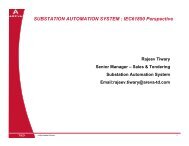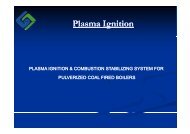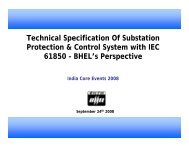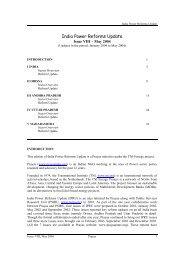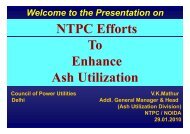residual life assessment (rla) based renovation ... - India Core
residual life assessment (rla) based renovation ... - India Core
residual life assessment (rla) based renovation ... - India Core
You also want an ePaper? Increase the reach of your titles
YUMPU automatically turns print PDFs into web optimized ePapers that Google loves.
2.3.4 Ultrasonic Testing (UT)<br />
By using ultrasonic sound waves, the sub-surface flaws and non-metallic inclusions<br />
can be detected. Size and configuration are also determined and recorded. The<br />
testing is carried out using suitable techniques and probes depending on the<br />
component geometry and its location. Wire brushing and light grinding are<br />
employed to mend local irregularities and undulations on the surface, if any.<br />
Machine oil mixed with grease is used as couplent. All accessible critical areas are<br />
examined ultrasonically using normal and angle probes. These include steam<br />
chests, casings, rotors, welds in stationary components etc. The surfaces thus<br />
prepared, are first checked with 2-4 MHz normal probes followed by 45° angle<br />
probes. The circumferential welds are checked with 45/60° angle probes.<br />
2.3.5 Hardness Test<br />
Hardness can be used as an indicator for the state of the steel in its <strong>life</strong> cycle.<br />
Hardness measurements provide a useful indication of the extent of microstructural<br />
degradation due to thermal exposure and creep damage in components operating<br />
at high temperatures and pressures. In-situ hardness testing is performed at<br />
suitable locations, using portable hardness tester. All critical areas, especially the<br />
high temperature zones of rotor, heat affected areas of welds in stationary parts are<br />
tested for their hardness.<br />
2.3.6 In-situ Metallographic Examination by Replication Technique<br />
Replication is the technique adopted to obtain microstructure in-situ by nondestructive<br />
metallography. In this technique, each of the spots chosen for<br />
examination is finely polished using portable metallographic surface preparation<br />
equipment, etched by suitable chemical agent, examined by microscope and the<br />
reverse image of the metal surface is taken on to a plastic replicating film for<br />
detailed laboratory examination. The replica of the microstructure is examined at<br />
site for its quality by portable optical microscope.<br />
All the critical areas of the rotors and the stationary components with special<br />
attention to the high temperature zone and welds are metallographically examined<br />
and their replica taken. If any defect has been observed by non-destructive testing<br />
at any zone, then such zones are given extra attention. The replicas are first<br />
examined in the laboratory under light microscope for gross metallurgical structure<br />
and then, if necessary, under the Scanning electron microscope for detection of<br />
creep damage, if any.<br />
2.4 TESTS PERFORMED ON CRITICAL TURBINE COMPONENTS<br />
2.4.1 Turbine Rotors<br />
International Conference & Exhibition<br />
<strong>India</strong> Thermal Power-4<br />
Page 4 of 22



